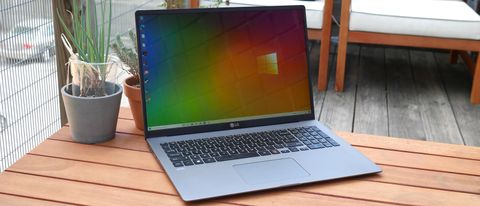Laptop Mag Verdict
LG's Gram 17 remains an astonishingly lightweight 17-inch laptop but there are some tradeoffs you'll need to consider.
Pros
- +
Sharp, colorful 17-inch display
- +
Astonishingly lightweight
- +
Good port selection
- +
Fast SSD
Cons
- -
Subpar battery life
- -
CPU performance lags behind rivals
- -
Bland design
- -
Lid and keyboard flex
Why you can trust Laptop Mag
Price: $1,499
CPU: Intel Core i7-1065G7
GPU: Intel Iris Plus
RAM: 16GB
Storage: 512GB SSD
Display: 17-inch, 2560 x 1600-pixel
Battery: 7:10
Size: 15 x 10.3 x 0.7 inches
Weight: 3 pounds
Buying a laptop is always an exercise in compromise. One of the tradeoffs you normally need to consider is that the bigger the laptop screen, the heavier it is. It's basic physics, right? Well, it was until LG released the Gram 17, a 17-inch laptop that weighs less than 3 pounds. After years of refinement, the Gram 17 hit a stage last year where we considered it the best 17-inch laptop on the market.
The newest model doesn't change much from that winning formula, and yet, we aren't as impressed by it this time around. Sure, the laptop nails its selling points; the Gram 17 is still remarkably lightweight and the 17-inch panel is fantastic. Everything else, however, underwhelms.
Unlike the previous model, the new Gram 17's battery life is below-average, the CPU performance lags behind competitors, and the speakers distort at maximum volume. And while the Gram 17's design deserves praise for being lightweight, it lacks refinement and flexes in all of the wrong ways.
The Gram 17 is still a compelling laptop for those who want a large display in a portable chassis, but it is no longer the out-and-out best 17-inch laptop.
LG Gram 17 price and configuration options
The Gram 17 we reviewed is available at select retailers starting at $1,499. Costco currently sells this unit for $1,249 after a $250 discount. The laptop has an Intel Core i7-1065G7 CPU, 16GB of RAM, a 512GB SSD and a 2560 x 1600-pixel display.
There is a $1,849 model you can buy directly from LG. This pricier config has a Core i7-1065G7 CPU, 16GB of RAM and a 1TB M.2 SSD.
LG Gram 17 design
The Gram 17 is a sleek, ultra-lightweight laptop with a bland appearance.
Before I critique the design any further, LG deserves praise for using magical materials to bring the weight of a 17-inch laptop down to 3 pounds. This isn't unobtanium, it's magnesium alloy — an increasingly common material found in portable laptops.
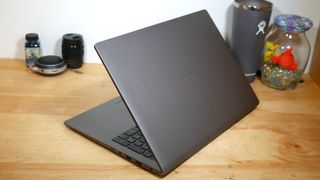
How lightweight is the 15 x 10.3 x 0.7-inch Gram 17, really? It, rather incredibly, weighs less than the 15-inch Microsoft Surface Laptop 3 (3.4 pounds) and makes lifting the 16-inch Apple MacBook Pro (4.3 pounds) and Dell XPS 17 (5.5 pounds) feel like a workout.
Aesthetically, the Gram 17 misses the mark. Remove the chrome "gram" logo from the center of the Gram 17's lid and it could be mistaken for props used in Ikea showrooms to inspire office arrangements. I'm not against a minimalist aesthetic, I just wish LG did something to elevate the Gram 17 and make you feel better about the $1,499 charge.
Without any embellishment — patterns, textures, trim or unique materials — the Gram 17 doesn't give your eyes anything to be drawn toward. Instead, there are wide, blank surfaces of dark silver, which, to its credit, has a pleasant pearlescent sheen. Opening the lid reveals the massive 17-inch screen surrounded by a relatively thin plastic bezel.

Below the keyboard are a large deck with a full-sized keyboard (with numpad) and a sunken touchpad. There’s more of the dark silver tone on the deck mixed with white Gram branding and orange-colored shortcut font.
The power button, located in the top-right corner of the keyboard numpad, doubles as a fingerprint reader so you can log in using Windows Hello. Unfortunately, there is no IR camera option for facial recognition login.
Build quality is also a concern. The Gram 17's lid could double as a trampoline given how much it flexed when I applied light pressure to the Gram logo. The same can be said for the keyboard, which bounced up and down as I pressed on it. This didn't disrupt my typing experience, but it made me question the long-term durability of this notebook.
LG Gram 17 ports
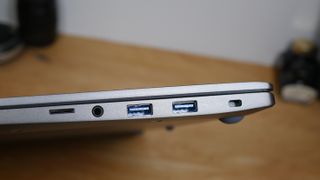
Other than a second Thunderbolt 3 port, the Gram 17 isn't missing any important connections. On the right side are two USB 3.1 Type-A ports, a microSD card slot, a headphone/mic jack and a lock slot.
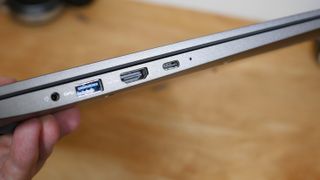
On the left side, you'll find a third USB 3.1 port, an HDMI input and the lone Thunderbolt 3 port. Instead of charging via the USB-C port, the Gram 17 uses a standard AC jack on the left.
LG Gram 17 display
Working, streaming and playing on such a large display is pretty magnificent. It helps that the Gram's 17-inch, 2560 x 1600-pixel non-touch panel hits all the right notes — it's sharp, colorful and bright.
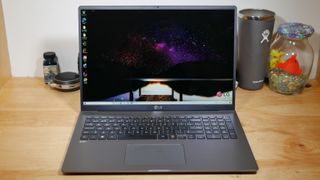
In fact, I hope I have a Gram 17 around when No Time to Die is released on DVD because I was thoroughly entranced watching the trailer for this 007 flick on the 17-inch panel. I could see the battle scars James Bond suffered from previous bouts in a closeup of Daniel Craig's face.

His blue eyes were the same brilliant sapphire hue as those of a White Walker while a ball of flame was a cascade of yellows and oranges. Keep in mind that this panel is very glossy, so reflections can be a problem in well-lit rooms or outside under the sun.
According to our colorimeter, the Gram 17's display clocked 104% of the sRGB color gamut. While not a bad score, the Gram is outclassed by the XPS 17 (132%), MacBook Pro (114%) and the premium laptop average 119%.
Similarly, the Gram 17's panel gets relatively bright, at 332 nits, but it's dimmer than those on the XPS 17 (505 nits), MacBook Pro (429 nits) and the average laptop (379 nits).
LG Gram 17 keyboard and touchpad
I have mixed feelings about the keyboard. On one hand, all of the keys are properly sized and spaced, the arrow keys are isolated in an inverse-T pattern and there is even a numpad blocked off on the right side. These features make the keyboard great for productivity, like when you're punching in numbers or navigating through a dense spreadsheet.
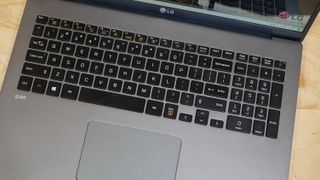
And while they're more shallow than I'd expect from a 17-inch laptop, the keys have a nice bounce to them, which made it easier for my fingers to jump from one key to the next. As a result, I typed at 120 words per minute with an accuracy of 95%, which is a bit faster than my usual 119-wpm average.
Unfortunately, the typing experience is let down by one questionable decision. Instead of positioning the touchpad directly below the spacebar, so as to make it align with the home row, LG chose to center it.

The problems are twofold. Centering the touchpad increases the likelihood of accidental swipes because your right palm rests directly on top of it. Even more annoying is that I needed to awkwardly reach over to the right in order to use the touchpad with my index finger or thumb while remaining on the home row.
And that's a shame because the 4.8 x 2.8-inch surface was quick to register my erratic finger movements as I navigated Windows 10 and executed simple gestures, like pinch-to-zoom and three-finger swipe to switch between programs.
LG Gram 17 audio
The Gram's dual speakers sound nowhere near as good as those on the 16-inch MacBook Pro or the XPS 17. It's not exactly a fair comparison, but I at least expect a decent quad-speaker setup on a 17-inch laptop. Instead, the Gram has two adequate drivers that distort at maximum volume and lack any semblance of bass.
When I listened to Glass Animals' "It's All So Incredibly Loud," Dave Bayley's falsetto vocals were piercing and the synthetic drum tones fell flat. The audio was clean and clear but lacked depth.
LG Gram 17 performance
Wielding an Intel Core i7-1065G7 CPU and 16GB of RAM, the Gram 17 effortlessly loaded two dozen Google Chrome tabs, allowing me to browse the web and listen to music through YouTube Music. The laptop chugged right along without a hint of lag even after I streamed four 1080p YouTube videos and a pair of Twitch Let's Plays. I wouldn't use it for gaming, but for heavy workloads, the Gram 17 works great.
The Gram 17's benchmark performance scores are also good, but remember, it uses a U-series processor so you won't get the same speeds as other 17-inch laptops. On a positive note, the new Gram 17's score of 15,626 on the Geekbench 4.3 test outpaced its predecessor (14,039, 8th Gen Core i7).
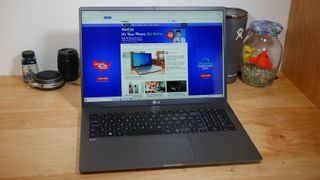
However, with a score of 3,439 on the Geekbench 5 test, the Gram 17 was demolished by the XPS 17 (7,740, Core i7-10875H), the MacBook Pro (7,201, Core i9-9980HK) and the average laptop (4,041).
The Gram 17 really struggled in our Handbrake video transcoding test, a trend we've seen across laptops that use 10th Gen Ice Lake CPUs. It needed 23 minutes and 59 seconds to convert a 4K video to 1080p resolution whereas the previous model took 19:18. The XPS 17 (8:41) and MacBook Pro (8:00) sliced that time into thirds while the average premium laptop (18:39) got the job done with 5 minutes to spare.
One bright spot comes from the Gram 17's quick 512GB M.2 PCIe SSD. The storage drive took just 5 seconds to duplicate 5GB of multimedia files for a transfer rate of 1,128.4 megabytes per second. It's one of the only SSDs we've tested to outpace the MacBook Pro (1,017.9 MBps) and it trounces the XPS 17 (620.6 MBps) and the Surface Laptop 3 (282.7 MBps). The category average is 683.8 MBps.
LG Gram 17 graphics
The Intel Iris Plus graphics in the Gram 17 are a step-up from what we're used to when we hear "integrated" but it's still not enough to run demanding games.
Sid Meier's Civilization VI: Gathering Storm played at a measly 12 frames per second, which isn't close to our 30-fps playability threshold. Less demanding games, like Dirt 3, should run just fine at 1080p on High settings.
LG Gram 17 battery life
The Gram 17 lasted for only 7 hours and 10 minutes on our battery test, a significant decline from the nearly 12 hours of runtime its predecessor achieved.
In comparison, the XPS 17 with a 4K panel endured for 9:05 while the MacBook Pro went the distance, at 10:55. Even the Surface Laptop 3 (8:00), which failed to hit the category average (9:33) outlasted the Gram 17.
LG Gram 17 cameras
LG smartphones have great selfie cams, so why not put one of those on the Gram 17? It's a question I kept asking myself as I stared back at the hazy, noise-filled selfie I snapped in my apartment. Maybe putting a smartphone lens in a laptop isn't that simple or perhaps it's more expensive than what LG is comfortable with; regardless, the Gram 17's 720p webcam — like most we tested — isn't good. We recommend opting for an external webcam instead, especially if you're working from home.
LG Gram 17 heat
With such a large area to disperse heat onto, the Gram 17 had no issues during our heat test, which involves playing a 15-minute, 1080p video. The hottest part of the laptop, above the F9 key, matched our 95-degree Fahrenheit comfort threshold.
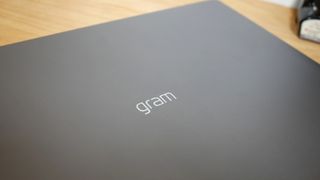
The underside is typically the hottest part of a laptop during our heat test, yet it only 90 degrees on the Gram 17. The touchpad was downright cool, at a breezy 77 degrees.
LG Gram 17 software and warranty
LG includes a few useful utilities on the Gram 17, including LG Control Center, where you can adjust power management settings, screen color temperature, security settings, and get product info. It could use some updating because the app appears in a tiny un-sizable window as if it were built for mobile.
I wish it was built into Control Center, but the LG Update Center app is where you can get all the latest drivers and patches to keep your system up-to-date. There is also a troubleshooting app if you're having issues with your Gram and a guide showing you how to take full advantage of the laptop.
- Laptop Tech Support Showdown! Our 2020 ratings
There is also a suite of Cyberlink apps for multimedia users who want to edit videos (PowerDirector 14, ColorDirector 5) or photos (PhotoDirector). Other third-party software you typically find in Windows 10 Home includes Candy Crush Friends Saga, Farm Heroes Saga and LinkedIn.
The Gram 17 ships with a one-year standard warranty.
Bottom line
Last year's Gram 17 was a breath of fresh air. After years of struggling to make a viable ultra-lightweight laptop, LG had finally turned a corner. Unfortunately, the latest model feels like a step in the wrong direction. Yes, the Gram 17 has an unbelievably lightweight chassis (3 pounds) and the large 17-inch panel is as sharp and colorful as you'd expect from LG.
However, everything else about the laptop is, well, uninspired. The design is bland, lacking any eye-catching elements, not to mention the durability concerns I have for it. While I have no problems with the keys themselves, they aren't properly aligned with the touchpad. And while I'm rattling off my complaints, the speakers distort at maximum volume, battery life is a disappointment and other 17-inch models deliver much faster performance.
Yet, despite these shortcomings, the Gram 17 will be perfectly suited to some users. It's the only 17-inch laptop on the market that is genuinely portable. I can see myself sliding into my backpack and taking it on long trips or just carrying it around my house from the couch to the office. There are other better 17-inch laptops on the market — like the Dell XPS 17 — but they cost more and are much heavier. If a big screen in a lightweight chassis is all you need, get the Gram 17 — there's nothing else like it.
Phillip Tracy is the assistant managing editor at Laptop Mag where he reviews laptops, phones and other gadgets while covering the latest industry news. After graduating with a journalism degree from the University of Texas at Austin, Phillip became a tech reporter at the Daily Dot. There, he wrote reviews for a range of gadgets and covered everything from social media trends to cybersecurity. Prior to that, he wrote for RCR Wireless News covering 5G and IoT. When he's not tinkering with devices, you can find Phillip playing video games, reading, traveling or watching soccer.
